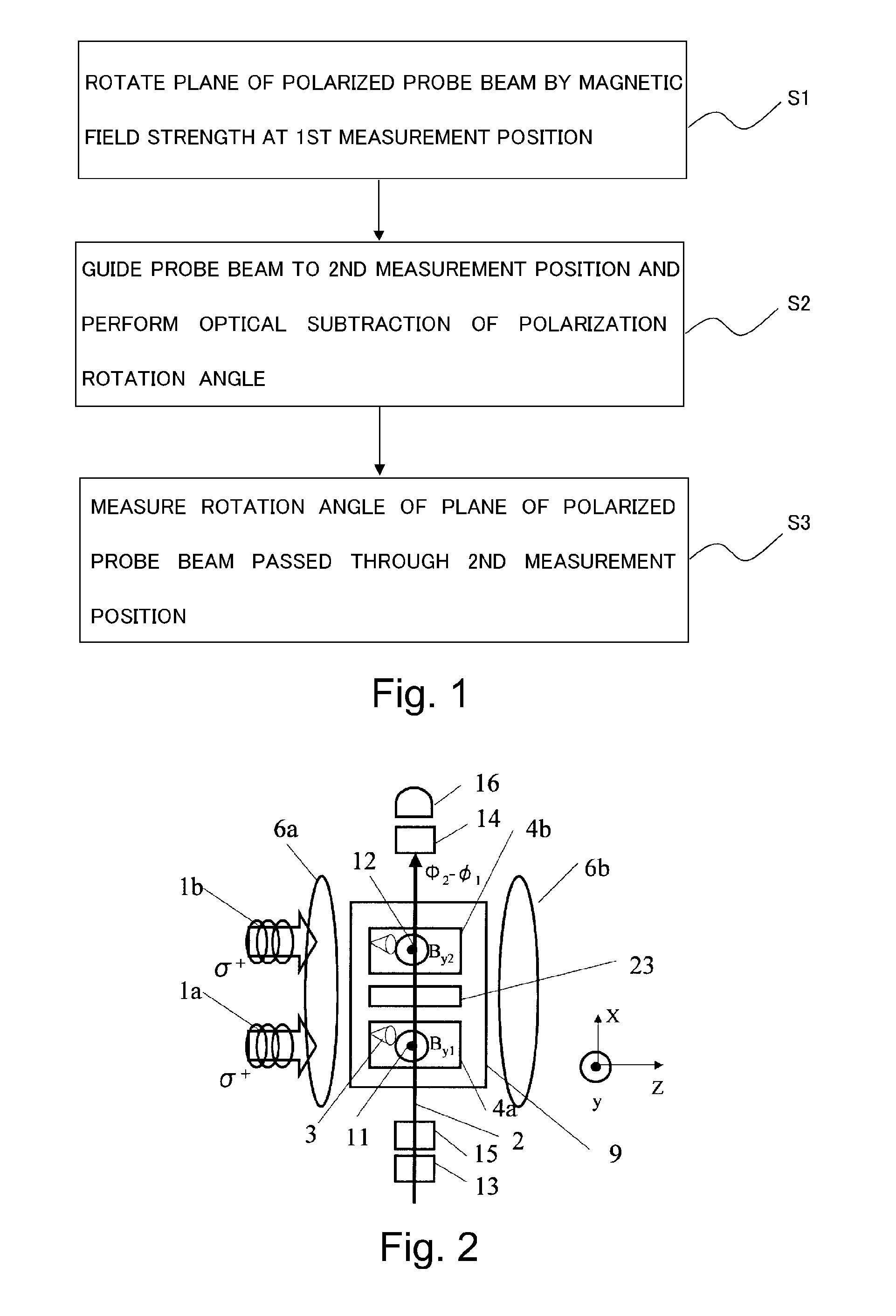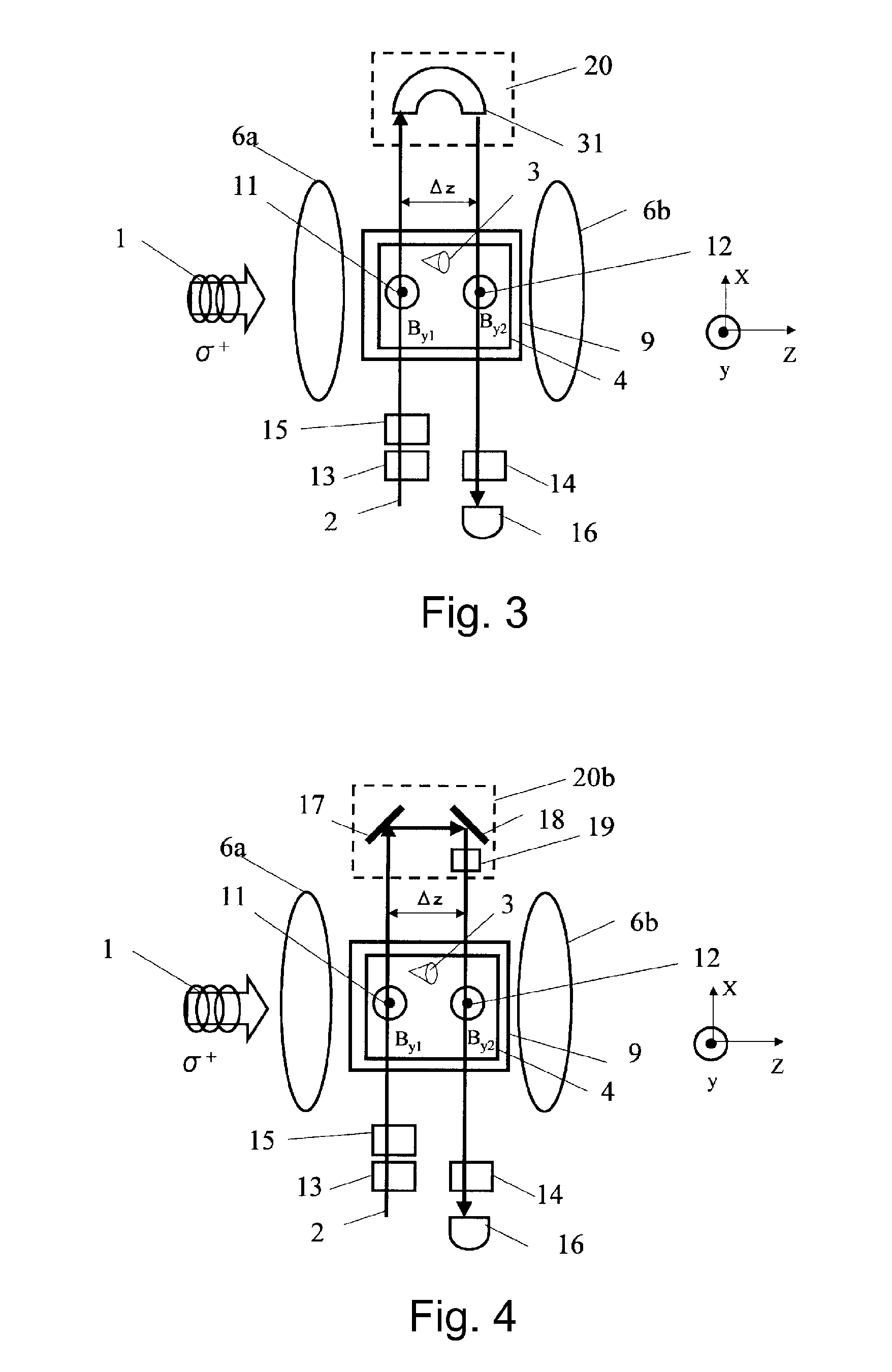Atomic magnetometer and magnetic sensing method
a magnetometer and magnetic sensing technology, applied in the direction of magnetic measurement, instruments, measurement devices, etc., can solve the problems of mixing noise, the condition concerning the amplification factor or noise of the individual photo-detector per se is not strictly uniform,
- Summary
- Abstract
- Description
- Claims
- Application Information
AI Technical Summary
Benefits of technology
Problems solved by technology
Method used
Image
Examples
first embodiment
Method
[0039]The magnetic sensing method according to the present invention in this embodiment will be described with reference to FIG. 1.
[0040]The magnetic sensing method in this embodiment has the following features.
[0041]That is, directions of spin of atoms constituting an atomic group contained in a hollow portion of a cell are uniformized by irradiating the atomic group with a pump beam. Then, the atomic group uniformized in spin direction of the atoms is irradiated with linearly polarized light as a probe beam to measure an angle of rotation of a plane of polarization of the probe beam, so that information on a measured magnetic field intensity is obtained.
[0042]In this embodiment, as shown in FIG. 1, first, a direction of polarization of the probe beam is rotated by a magnetic field intensity at a first measurement position (S1). Then, the probe beam with the rotated direction of polarization by the magnetic field intensity at the first measurement position is guided to a seco...
second embodiment
er
[0061]An atomic magnetometer in this embodiment has the following features.
[0062]Specifically, the atomic magnetometer includes a cell having a hollow portion, an atomic group contained in the hollow portion, and a pump beam light source for uniformizing directions of spin of a plurality of atoms constituting the atomic group. The atomic magnetometer further includes a probe beam light source for irradiating the cell with linearly polarized light as the probe beam, and a detector for detecting information on an angle of rotation of a plane of polarization of the linearly polarized light.
[0063]With respect to the atomic group in the cell, an irradiation direction of the circularly polarized light providing the pump beam and an irradiation direction of the probe beam are configured to intersect with each other at a first measurement position.
[0064]Then, with respect to the atomic group in the cell, an irradiation direction of the circularly polarized light providing the pump beam an...
third embodiment
[0073]The above-described First Embodiment and Second Embodiment are explained on the premise that the circularly polarized light is used as the pump beam but as shown below, the pump beam is not always required.
[0074]Specifically, a magnetometer in this embodiment is provided with a light source for a probe beam and a medium through which the probe beam is configured to propagate.
[0075]The medium is a substance which changes a polarization rotation angle depending on a magnetic field intensity at a first measurement position and a magnetic field intensity at a second measurement position and may specifically be vapor of alkali metal such as potassium or cesium. Further, rare gas (noble gas) such as helium or xenon may also be utilized. Further, it is also possible to employ substances, such as magnetic materials including Fe, Co, Ni, Y3Fe12, MnSb, MnBi, YFeO3, NdFe3, CrBr3, EuO, CdCv2S4, etc., and glass and the like. Further, a (magnetic field) gradiometer can also be realized by d...
PUM
 Login to View More
Login to View More Abstract
Description
Claims
Application Information
 Login to View More
Login to View More - R&D
- Intellectual Property
- Life Sciences
- Materials
- Tech Scout
- Unparalleled Data Quality
- Higher Quality Content
- 60% Fewer Hallucinations
Browse by: Latest US Patents, China's latest patents, Technical Efficacy Thesaurus, Application Domain, Technology Topic, Popular Technical Reports.
© 2025 PatSnap. All rights reserved.Legal|Privacy policy|Modern Slavery Act Transparency Statement|Sitemap|About US| Contact US: help@patsnap.com



